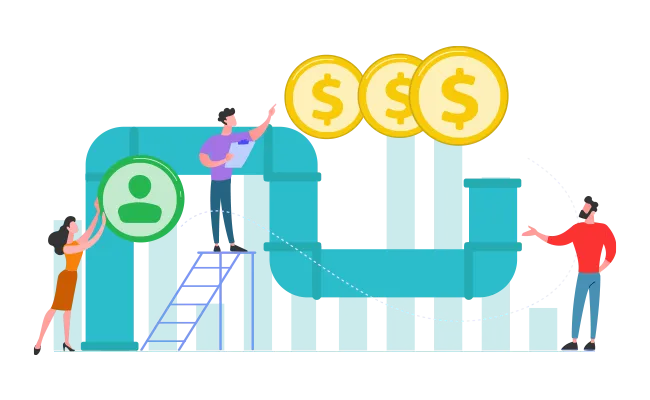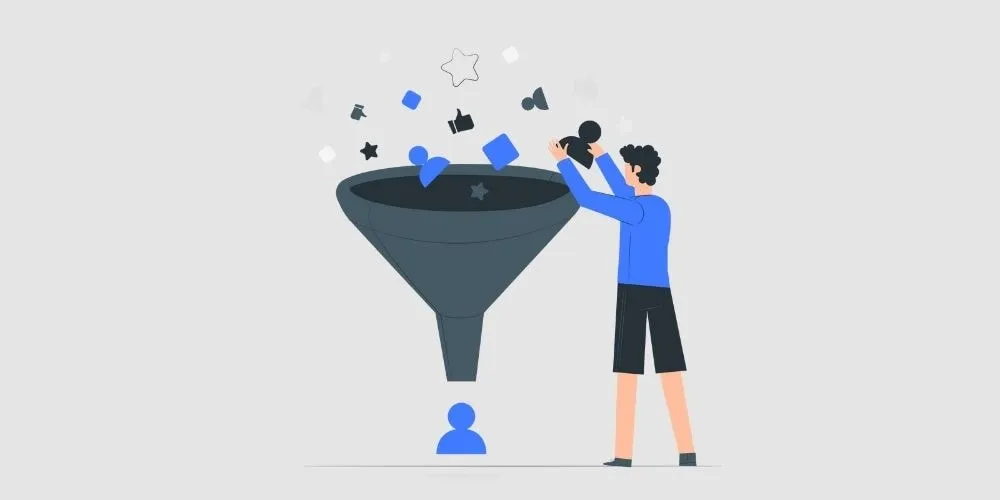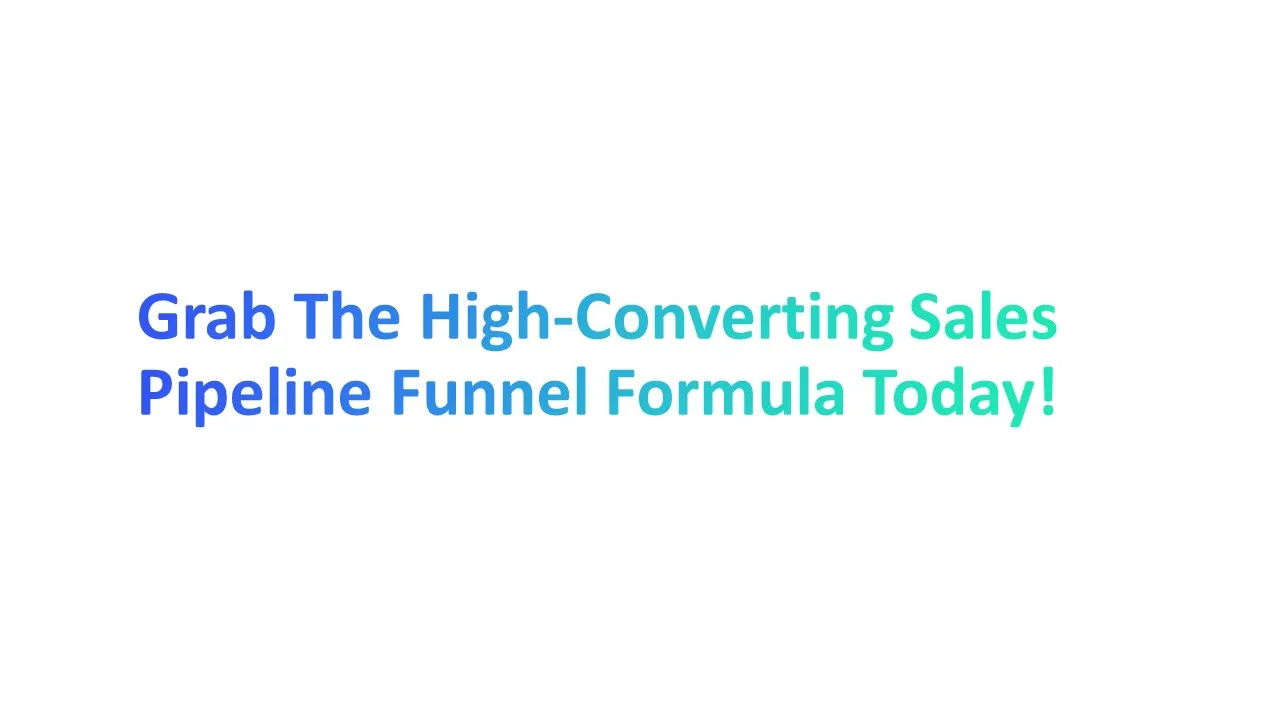Are you looking for a way to grow your sales and improve your conversion rates? A well-structured sales pipeline funnel is the key to turning leads into paying customers.
Studies show businesses using optimized sales pipelines increase revenue by up to 28%. Keep reading to discover how.
What is a Sales Pipeline?

A sales pipeline is a step-by-step process that helps you track potential customers as they move from showing interest to making a purchase. The sales pipeline helps you know where each prospect is in the buyer's journey, so you can focus your efforts.
Sales Pipeline Stages
- Lead Generation: This is where you first find potential customers, also known as leads. Your goal is to get their attention and introduce your product.
- Making the right impression during initial contact can make or break a lead’s journey through the sales funnel.
- Qualification: Here, you figure out if the lead is a good fit for your product or service. Are they ready to buy? Do they need what you’re offering?
- Proposal: At this stage, you present a solution that fits the customer’s needs. This could be a written proposal or a detailed conversation.
- Negotiation: This is where you work with the customer to finalize the deal. It often involves answering questions or adjusting terms.
- Closing the Deal: Once the customer agrees, they make the purchase, and the sale is complete!
What is a Sales Funnel?

A sales funnel is a tool that shows the journey a customer takes from learning about your product to making a purchase. It’s called a funnel because it starts with a wide range of potential customers at the top, but only a few become paying customers at the bottom.
Sales funnels are crucial to understanding the customer’s decision-making process and guiding them towards a purchase.
Sales Funnel Stages
- Awareness: At this stage, potential customers first learn about your product. They might see an ad or hear about it from a friend.
- Interest: Once they know about your product, they start to show interest. This could mean visiting your website or asking for more details.
- Decision: Here, the customer is comparing your product to others. They’re deciding whether to choose you or a competitor.
- Action: This is the final stage where the customer decides to make a purchase. Your sales rep closes the deal, turning them into a paying customer.
Why Sales Pipeline Funnels are Important in Sales Process?

1. Visual Clarity
A sales pipeline funnel provides a visual representation of each stage a customer goes through, from lead generation to making a purchase.
This helps your sales team understand where each potential customer is and what actions to take next to increase sales again.
2. Better Conversion Rates
With a clear funnel, you can track potential customers' progress and focus on sales strategies that convert more leads into paying customers.
By using both a sales pipeline and understanding each step of the funnel, you improve the chances of closing more deals.
3. Improved Forecasting and Reporting
The sales funnel allows you to create an accurate sales forecast by showing how many leads are likely to become paying customers.
This helps your own sales leaders and managers plan better and improve overall sales pipeline management.
Good sales managers tracks both the funnel and pipeline to ensure the team is hitting its targets.
4. Optimized Sales Efficiency
A well-structured sales pipeline funnel makes your sales process more efficient.
By tracking conversion rates and the performance of your sales teams, you can identify and fix any bottlenecks that slow down sales efforts. This ensures a smoother and faster path to success.
Monitoring the year's sales cycle helps in adjusting both the sales pipeline and funnel strategies.
Key Differences Between a Sales Funnel and a Sales Pipeline

1. Sales Funnel Focuses on the Customer Journey
- A sales funnel shows the steps a potential customer goes through before making a purchase.
- The stages include awareness, interest, decision, and action.
- It highlights the customer’s journey through the buying process.
2. Sales Pipeline Tracks Sales Rep Activities
- A sales pipeline focuses on the actions taken by the sales rep.
- It tracks steps like lead generation, qualifying leads, sending proposals, and closing deals.
- This helps the sales team convert leads into paying customers.
3. Visual Representation Differences
- The sales funnel is visualized as a funnel that starts wide with many leads and narrows down as fewer people progress through the stages.
- The sales pipeline is linear, representing the specific actions taken by sales reps at each stage to move leads toward a sale.
Sales funnel vs sales pipeline comparisons help businesses optimize their approach to lead management and deal closing.
4. Purpose and Goal
- The goal of the sales funnel is to understand where potential customers are in their buying process. This helps your marketing and sales team know what kind of message or offer to send.
- The sales pipeline helps sales teams track progress toward hitting their sales goals by monitoring deals at each stage.
In simple terms, the sales funnel is customer-focused, while the sales pipeline is team-focused. Together, they help you manage both the customer journey and the actions of your sales team.
How to Align Sales Pipelines with Funnels

1. Map Funnel Stages to Pipeline Stages
The first step is to connect each stage of the sales funnel with various stages in your sales pipeline. The funnel tracks the customer journey, from becoming aware of your product to making a purchase. The pipeline, however, tracks what your sales team is doing to convert that customer.
Here’s how to do it:
- Awareness stage (funnel) aligns with the lead generation stage (pipeline). Here, your marketing team attracts potential customers.
- Interest and decision stages (funnel) match with the qualification and proposal stages (pipeline). This is where your sales reps engage leads, qualify them, and offer solutions.
- The action stage (funnel) connects to the closing stage (pipeline) when the deal is finalized, and the customer makes a purchase.
2. Establish Clear Conversion Criteria
Each stage of the funnel and pipeline stage should have a clear reason for moving a lead to the next stage. This is known as conversion criteria. For example:
- A lead may move from the awareness stage to the interest stage if they download a brochure or ask for more information.
- They might move from proposal to closing when they agree on pricing or terms.
By setting these clear criteria, you ensure that leads are only progressing through your sales pipeline funnel when they’re ready, saving time and effort.
3. Use CRM Tools for Seamless Integration
Next, you can use CRM tools to make sure your funnel and pipeline are always in sync. CRM (Customer Relationship Management) software helps your team track leads, monitor progress, and manage customer interactions.
By automating tasks like lead scoring and deal tracking, your sales and marketing teams can work more effectively together.
Here’s how:
- A CRM system can automatically move a lead from one stage to another based on specific actions, like opening an email or requesting a demo.
- It keeps both your sales funnel and pipeline updated in real time, helping your team focus on the right leads at the right time.
4. Ensure Consistent Communication
One of the most important things in both your sales funnel and pipeline is clear communication. When your sales and marketing teams share information regularly, it ensures that everyone is on the same page.
Here’s how to do it:
- Set up regular meetings between your sales teams and marketing teams to discuss goals and leads.
- Use a shared tool like a CRM system to keep track of customer interactions. This helps both teams see who is doing what.
- Encourage open communication through emails or messaging platforms so no one is left guessing what the next step is.
Coordinating your marketing efforts with sales can significantly improve your funnel’s effectiveness.
5. Focus on Lead Qualification
Not every lead that enters the funnel is ready to buy. That’s why you need to qualify leads before pushing them through lead qualification stage of the sales pipeline. Lead qualification helps your team focus on the most promising prospects.
Here’s how to do it:
- Use a scoring system to rank leads based on their actions (e.g., did they open an email or request a demo?).
- Set clear criteria for what makes a lead qualified to move to the next stage. For example, a lead might qualify if they show interest in pricing or ask specific questions about your product.
- Make sure that only qualified leads are sent to the sales rep. This saves time and increases your chance of closing the deal.
6. Create Unified Metrics for Success
To measure how well your funnel and pipeline are performing, it’s important to track unified metrics. These metrics help you understand what’s working and where things might need improvement.
Here’s how to do it:
- Track metrics like conversion rates, the number of qualified leads, and the average time it takes to close a deal.
- Set shared goals for your sales and marketing teams so they know what to aim for. This creates a clear target for everyone involved.
- Regularly review these metrics in meetings to make sure you’re on track and identify any areas for improvement.
7. Align Content to Each Stage
Each stage of the sales funnel needs content that matches where the customer is in their journey. For example, someone in the awareness stage is just learning about your product, so they need educational content like blog posts or videos.
Meanwhile, someone in the decision stage is ready to buy and may need case studies or pricing details.
Here’s how to do it:
- Create content for each stage of the funnel (awareness, interest, decision, and action).
- Use tools like CRM to track which content is being used at each stage.
- Make sure the content is easy to understand and answers the customer’s questions.
- Different marketing strategies are necessary to guide leads through various stages of the funnel.
8. Regularly Review Sales Funnel and Pipeline Reports
To keep things running smoothly, you should regularly review reports from both your sales funnel and sales pipeline. These reports show you how leads are moving through the funnel and pipeline, and they help you spot any problems early.
A thorough sales pipeline report offers insights into deal progress and where improvements are needed in the sales process.
Here’s how to do it:
- Look at conversion rates to see how many leads are moving to the next stage.
- Track how long leads stay in each stage and identify any delays.
- Review reports in regular meetings with your sales and marketing teams to find areas for improvement.
9. Align Sales Team and Marketing Teams
When the sales team and marketing team work together, your funnel and pipeline flow more smoothly. The marketing team helps fill the funnel with leads, while the sales team moves them through the pipeline and sales funnel together.
Here’s how to do it:
- Have regular meetings where both teams share updates and strategies.
- Use shared tools like a CRM to keep everyone on the same page.
- Set common goals, like the number of qualified leads or the conversion rates from one stage to the next.
10. Optimize the Sales Cycle with Data
Data is key to improving your sales cycle. By tracking key metrics, you can identify areas where the funnel or pipeline needs improvement.
Here’s how to do it:
- Track important data points like how long it takes to close a sale or the conversion rates at each stage.
- Use data to adjust your sales strategy. If certain content is working better at a particular stage, create more of it.
- Regularly review the data to see where you can make improvements.
Aligning your sales pipeline with your sales funnel through these steps ensures that both tools work together to move leads through the sales process and close more deals.
Common Pitfalls in Sales Pipeline Funnels to Avoid

1. Not Adjusting the Sales Funnel for Different Buyer Journeys
Every buyer has a unique journey. Some take longer to decide, while others move quickly. If your sales funnel treats all buyers the same, you could lose potential customers.
How to avoid it:
Customize your funnel for different stages and for different buyer personas. For example, a new customer might need more education, while a returning customer may just need a discount.
Use tools like CRM to track where each lead is in their journey and adjust your approach accordingly.
2. Neglecting Sales Pipeline Metrics
Ignoring important sales pipeline metrics is a major mistake. If you’re not tracking things like conversion rates or lead times, it’s hard to know what’s working and what needs improvement.
How to avoid it:
Set up regular reviews of your sales pipeline reports. Track key metrics like how long it takes to close a deal or how many leads drop off at each stage.
Use these reports to adjust your strategy. If you notice a drop-off at a certain stage, you can address it before it affects your overall performance.
3. Ignoring Sales Funnel Drop-Off Points
A big mistake is ignoring where leads fall out of your sales funnel. If you’re losing leads at certain stages, it’s a sign that something needs fixing.
How to avoid it:
Identify the stages where most leads drop off. For example, are people leaving after a product demo sales meeting, or not responding to follow-up emails?
Adjust your strategy at these points. If a demo isn’t converting, try offering a free trial or more detailed product information to keep leads moving through the funnel.
4. Underestimating Sales Pipeline Management
Many companies make the mistake of not managing their sales pipeline properly. Without regular checks, your leads can get stuck, and you might miss out on potential sales.
How to avoid it:
Set up regular reviews of your sales pipeline management process.
Use CRM tools to track lead progress and ensure no one is left behind. Keep an eye on your conversion rates and adjust your strategy when you see any roadblocks.
5. Overlooking the Need for Sales Proposal Refinement
Sending out a generic sales proposal to all leads is a missed opportunity. Each potential customer has different needs, and a one-size-fits-all approach won’t work.
How to avoid it:
Customize each sales proposal based on the lead’s specific pain points or interests.
Make sure to highlight the key benefits of your product that matter to them. Regularly update your proposals based on feedback and market changes.
6. Focusing Only on New Customers
Many businesses put too much focus on gaining new customers, forgetting that existing customers are just as important.
How to avoid it:
Build strong relationships with your existing customers by staying in touch. Offer special deals or rewards to loyal customers.
Track how much revenue you’re generating from repeat business.
By focusing on both new and existing customers, you can increase your customer retention and long-term revenue.
7. Failure to Adapt Sales Strategies
If your sales strategy stays the same, you risk falling behind. Markets change, and so do customer needs.
How to avoid it:
Regularly review your sales strategies and look for areas where you can improve sales operations.
Adapt based on changes in your industry, feedback from your sales team, and the data from your own sales funnel reports. Keep learning and experimenting with new approaches.
Conclusion
A well-aligned sales pipeline funnel can be the key to grow your sales success. By understanding and managing each stage, from lead generation to closing the deal, you can guide potential customers smoothly through the buying process.
Regular reviews and adjustments to your strategy will ensure you meet your sales goals. Aligning your sales pipeline and funnel can be the key to long-term business success. Stay focused, adapt to changes, and watch your revenue grow.









